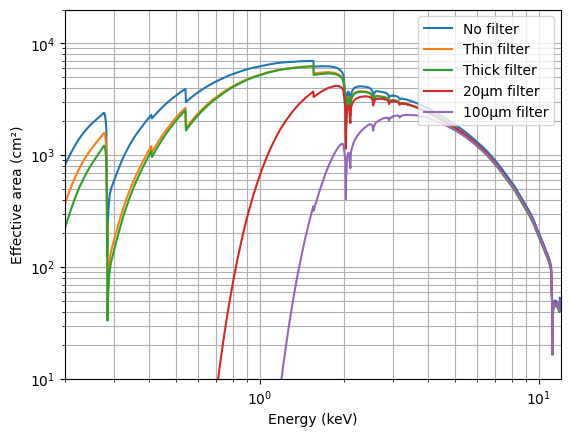
Date.
Figure: Effective area (cm²) of the X-IFU over the energy bandpass (keV) for its different optical configurations
The X-IFU has recently undergone several changes in its design. An important work ahead of the launch is to analyse, verify and understand the X-IFU capabilities when observing celestial sources. This is mostly performed through simulations, using as inputs typical spectra and shapes of the observed objects (derived from previous missions) and folding in our current understanding of the instrument. The latter is encapsulated – in a simplistic albeit accurate way – in what is called the “instrument response files”, used as inputs by our simulators of X-ray observations (XSPEC, SPEX, SIXTE, SIXSA…). These responses provide a representative view of the spatial, spectral and temporal response of the instrument, alongside several important effects needed to estimate the final X-IFU performances (crosstalk, vignetting, grading). Following the consolidation of the new X-IFU design, the most up-to-date responses are now available for the community on this page. These will allow scientist to understand the true potential of the X-IFU, prepare its observation plan and pave the way for future new discoveries.
–
Le X-IFU a récemment traversé une phase de profond changement dans son architecture. Une partie importante du travail avant le lancement consiste à analyser, vérifier et comprendre les capacités d’un tel instrument lors de l’observation de sources célestes. Cela passe essentiellement par la simulation d’observations, au travers d’entrées comme les spectres et formes des sources connues (issues de missions précédentes) convoluées par notre connaissance actuelle de l’instrument. Cette dernière est contenue – de manière simpliste mais précise – au sein de ce que l’on appelle des « matrices de réponse instrumentale », qui servent de point de départ pour tous nos simulateurs d’observations rayon X (XSPEC, SPEX, SIXTE, SIXSA…). Ces matrices de réponses donnent aux utilisateurs une idée des capacités spectrales, spatiales et temporelles de l’instrument, tout en incluant des effets instrumentaux fondamentaux pour les performances du X-IFU (diaphonie, vignettage, effet de notation). Suite à la consolidation de la nouvelle architecture instrument, les matrices de réponse les plus à jour sont désormais disponibles pour la communauté sur cette page. Ces matrices de réponse permettront aux scientifiques de comprendre le potentiel du X-IFU, de préparer le plan d’observations et de poser les jalons de futures nouvelles découvertes.


 Youtube
Youtube